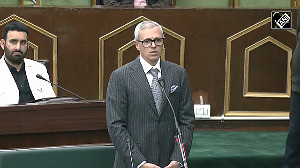India would remain among the fastest growing economies of the world in the medium-term as the country has posted a real GDP growth at 6.9 per cent in 2004-05, according to Reserve Bank of India.
RBI in its document on 'Macroeconomic and Monetary Developments in 2004-05', said with the real GDP growth at 6.9 per cent, India's macroeconomic performance turned out to be stronger than anticipated.
The document also states that despite unfavourable monsoons, real GDP originating in agricultural and allied activities rose by 1.1 per cent with foodgrains production at over 210 million tonne, industrial recovery firmed up and broadened, driven mainly by manufacturing and buoyant exports.
The Macroeconomic and Monetary Development report, which serves as a backdrop to the context and rationale of the monetary policy formulation, is issued on the day of the Annual Policy Statement. However, this time it has been issued a day earlier.
While services sector remained the main engine of growth, inflation conditions firmed up worldwide in 2004 and central banks began signaling a reversal of their accommodative monetary policy stance to stabilise inflation expectations, it added.
Commodity prices, especially that of crude oil, metals an coal, picked up as global demand outpaced supply alongside strengthening economic activity, while supply-side pressures dominated the domestic inflation scenario, RBI said.
April-August 2004 marked by hardening of domestic prices of coal, petroleum products and metals due to imported inflation and unfavourable South-West monsoon.
In September-March 2005, when inflationary pressures began to recede reflecting the waning of the impact of monsoon, fiscal measures to cushion the pass-through of international prices and monetary policy measures to drain excess liquidity and rein in inflation expectations, RBI said.
While the required reduction in the revenue deficit and the fiscal deficit of the Centre in the FRBM Rules was achieved, the budgeted targets for 2004-05 were missed.
Gross tax revenue stood at 3.7 per cent lower than the Budget estimates mainly on account of lower corporation tax collections and union excise duties. The aggregate expenditure net of debt swap transactions was lower than the budgeted level by one per cent, it said.
Major deficit indicators for states are budgeted to decline in 2004-05 with an ongoing endeavour of the state governments to carry forward fiscal reforms.
Centre's fiscal deficit is budgeted to decline to 4.3 per cent from 4.5 per cent in the preceding year during 2005-06 while net market borrowings are Budgeted to be higher at Rs 1,03,791 crore (Rs 1037.91 billion) as against Rs 45,943 crore (Rs 459.43 billion) in the revised estimates for 2004-05.
On the monetary and liquidity policy, RBI said that monetary conditions continued to be driven by large capital inflows in 2004-05 as in the previous year.
Money supply (M3) at 12.8 per cent remained well within the trajectory of 14 per cent projected by the Annual Policy Statement for 2004-05.
The growth in banks deposits was a shade lower than projected due to substitution in favour of postal deposits, RBI said.
RBI's foreign currency assets rose by Rs 1,15,044 crore (Rs 1150.44 billion) in 2004-05 on top of an accretion of Rs 1,41,428 crore (Rs 1414.28 billion) in 2003-04, while a "sharp rise in non-food credit" had set in from July 2004.
With the overhang of liquidity in the beginning of the year, combined with large capital inflows, RBI had to continually absorb liquidity during the year barring some episodic pressures.
Sterilisation operations were conducted through institution of a new mechanism called Market Stabilisation Scheme, it said.





 © 2025
© 2025